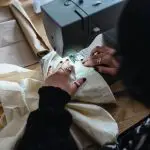Are you looking to give your leather a stylish makeover? Look no further!
In this article, we will guide you through the process of backing leather with fabric. By following our easy steps, you can transform your leather items into one-of-a-kind pieces with added durability and flair.
From selecting the right fabric to securing the final product, we’ve got you covered.
So, grab your materials and get ready to create a stunning fabric-backed leather masterpiece!
Table of Contents
Choosing the Right Fabric for Backing
When choosing the right fabric for backing, it’s important to consider the durability and color compatibility.
You want to ensure that the fabric you choose is strong enough to support the leather and withstand any wear and tear. Look for durable fabric options such as canvas or denim, as they are known for their strength and longevity. These fabrics can handle the weight and stress of the leather without tearing or fraying easily.
Additionally, consider incorporating patterns and textures into your fabric choice. This can add visual interest to your project and create a unique look. Choose patterns and textures that complement the leather and enhance its overall appearance. You can opt for subtle patterns or bold prints, depending on your personal style and the desired effect.
Keep in mind the color compatibility as well. Select a fabric color that complements or contrasts with the leather, ensuring a visually appealing final result.
Preparing the Leather and Fabric
Before you begin, make sure you have all the necessary materials for preparing the leather and fabric. Choosing suitable materials and ensuring proper alignment are crucial steps in the process of backing leather with fabric.
To prepare the leather, you will need the following materials:
| Materials | Purpose |
|---|---|
| Leather | The main material to be backed with fabric |
| Leather cleaner | To remove dirt and oils from the leather surface |
| Sandpaper | To smooth out any rough edges or imperfections |
| Leather conditioner | To moisturize and soften the leather before backing |
To prepare the fabric, gather the following materials:
| Materials | Purpose |
|---|---|
| Fabric | The backing material for the leather |
| Scissors | To cut the fabric to the desired size and shape |
| Fabric adhesive | To secure the fabric to the leather surface |
| Iron | To activate the adhesive and ensure a strong bond |
Ensure that the leather is clean and dry before applying any adhesive. Smooth out any wrinkles or creases in the fabric before attaching it to the leather. When aligning the fabric with the leather, make sure it is centered and straight to achieve a professional-looking result.
Applying Adhesive to the Leather
Once you have gathered all the necessary materials, such as adhesive and a brush, begin by applying adhesive to the surface of the leather. This step is crucial in ensuring a strong bond between the leather and fabric.
Here are some techniques to help you achieve a successful application:
-
Apply a thin, even layer of adhesive: Use a brush to spread the adhesive evenly on the leather surface. Make sure to apply a thin layer to avoid any excess glue seeping through the fabric.
-
Allow the adhesive to become tacky: After applying the adhesive, wait for it to become tacky. This will help in creating a stronger bond between the leather and fabric.
-
Press firmly and evenly: Once the adhesive is tacky, place the fabric onto the leather and press firmly and evenly. This will ensure that the fabric adheres well to the leather surface.
Troubleshooting adhesive application:
-
Excess glue: If you notice any excess glue seeping through the fabric, immediately wipe it off using a damp cloth. This will prevent it from leaving stains on the fabric.
-
Insufficient adhesive: If you find that the fabric is not sticking properly to the leather, reapply a thin layer of adhesive and press firmly again.
-
Bubbles or wrinkles: If you notice any bubbles or wrinkles in the fabric, smooth them out by gently pressing and stretching the fabric.
Affixing the Fabric to the Leather
When it comes to affixing fabric to leather, there are several adhesive options for bonding that you can consider.
Before applying any adhesive, it is important to properly prepare the leather surface by cleaning and sanding it to ensure optimal adhesion.
Additionally, achieving a seamless finish is crucial, and can be achieved by carefully aligning the fabric and using a roller or press to remove any air bubbles or wrinkles.
Adhesive Options for Bonding
To achieve a strong bond between the leather and fabric, you can use adhesive options such as fabric glue or spray adhesive. These adhesive types provide a secure and long-lasting bond for your leather and fabric project.
Here are some bonding techniques you can try:
- Apply fabric glue evenly on the backside of the fabric and press it firmly onto the leather surface.
- Spray adhesive on both the fabric and leather surfaces, allowing it to become tacky before pressing them together.
- Use a brush to apply a thin layer of contact adhesive on both materials, then press them together firmly.
- Consider using double-sided adhesive tape for a quick and easy bonding option.
Preparing the Leather Surface
Before applying any adhesive, it is important to prepare the surface of the leather for bonding with the fabric. This will ensure a strong and long-lasting bond between the two materials. One important step in preparing the leather surface is sealing it. This helps to prevent any moisture or dirt from penetrating the leather and affecting the bond. You can use a leather sealer or conditioner to accomplish this. Additionally, it is important to take measures to prevent fabric shrinkage during the bonding process. You can do this by pre-washing and pre-shrinking the fabric before applying it to the leather. This will help to minimize any potential shrinkage that could occur after the bonding is complete.
| Sealing Leather | Preventing Fabric Shrinkage |
|---|---|
| Use leather sealer or conditioner | Pre-wash and pre-shrink fabric |
| Apply sealer evenly on the leather surface | Follow fabric care instructions |
| Allow sealer to dry completely before bonding | Test fabric for shrinkage beforehand |
Achieving a Seamless Finish
In order to achieve a seamless finish, it’s important to ensure that the leather surface and fabric are aligned properly.
To begin, use sewing techniques such as basting or pins to hold the fabric in place before stitching. This will prevent any shifting or puckering during the sewing process.
When sewing, make sure to use a leather needle and a strong, durable thread that can withstand the tension. Troubleshooting common issues like skipped stitches or uneven tension can be resolved by adjusting the machine settings or using a walking foot attachment.
Additionally, take your time and work slowly to ensure accurate stitching and a clean, professional result.
Trimming Excess Fabric
When it comes to trimming excess fabric, there are two key points to keep in mind: neat fabric edges and proper fabric length.
To ensure a clean and professional finish, it’s important to carefully trim any frayed or uneven edges of the fabric.
Additionally, ensuring that the fabric is cut to the appropriate length will help achieve a polished look for your project.
Neat Fabric Edges
To achieve neat fabric edges, you’ll need to carefully trim any excess fabric before applying it to the leather. Trimming ensures a clean and professional look for your project. Here are some techniques to consider:
-
Hemming techniques for fabric edges: Hemming involves folding and stitching the edge of the fabric to prevent fraying. This can be done by hand or using a sewing machine. It creates a clean and durable finish.
-
Using bias tape for a clean fabric edge finish: Bias tape is a strip of fabric that is cut on the bias, which allows it to stretch and conform to curves. It can be used to encase the raw fabric edge, providing a neat and polished look.
-
Overcasting or serging the fabric edges: Overcasting or serging involves using an overlock stitch to enclose the raw edges of the fabric. This prevents fraying and gives a professional finish.
Proper Fabric Length
Make sure you measure and cut your fabric to the proper length before starting your project. Cutting techniques can greatly affect the outcome of your project and the durability of the fabric. It is important to use sharp scissors or a rotary cutter to ensure clean and precise cuts. Additionally, consider the fabric’s durability when cutting. Fabrics with a looser weave or delicate fibers may require more careful handling to prevent fraying or tearing.
Here is a table to help you understand the different cutting techniques and their impact on fabric durability:
| Cutting Technique | Fabric Durability |
|---|---|
| Straight Cut | Moderate |
| Bias Cut | High |
| Zigzag Cut | Low |
| Fringed Cut | Very Low |
Securing the Backed Leather
Securing the backed leather is essential to ensure the fabric remains in place. There are several securing methods you can use to achieve this.
One common method is to staple the fabric to the back of the leather. This is a quick and efficient way to secure the fabric, but it may not be suitable for all projects.
Another method is to use adhesive. This can be done by applying a thin layer of adhesive to the back of the leather and pressing the fabric onto it. This method provides a strong bond, but it may be more time-consuming and messy.
Alternatively, you can sew the fabric to the leather using a sewing machine or by hand. This method is ideal if you want a secure and durable attachment.
When it comes to alternative materials, you can also use upholstery nails or decorative tacks to secure the fabric to the leather. These can add a stylish touch to your project while ensuring the fabric stays in place.
Overall, choosing the right securing method and alternative materials depends on your specific project and personal preference.
Finishing Touches and Maintenance
Now that you have securely backed your leather with fabric, it’s time to add the finishing touches and learn some maintenance tips to keep your project looking its best.
To enhance the overall look of your project, you can consider adding decorative elements. This could include adding trims or piping along the edges or incorporating decorative stitching patterns. These small details can really elevate the aesthetic appeal of your leather-backed fabric.
When it comes to maintenance, there are a few tips to keep in mind. Regularly dusting or vacuuming your leather-backed fabric will help remove any dirt or debris that may accumulate over time. If you notice any spills or stains, it’s important to act quickly and gently blot the area with a clean cloth. Avoid using harsh chemicals or cleaners, as they may damage the leather or fabric.
Additionally, it’s a good idea to periodically condition the leather to prevent it from drying out or cracking. There are various leather conditioners available on the market that can help nourish and protect the leather.
Conclusion
In conclusion, backing leather with fabric is a straightforward process that can be done with the right materials and techniques.
By choosing the appropriate fabric, preparing the leather and fabric, applying adhesive, affixing the fabric, trimming excess fabric, securing the backed leather, and adding finishing touches, you can create a durable and stylish piece.
Remember to properly maintain your backed leather to ensure its longevity.
With practice and attention to detail, you can master this skill and enjoy the benefits of a customized and comfortable leather item.
- How Does Ring Spun Cotton Affect Garment Fit and Shape Retention? - August 13, 2024
- What Are the Challenges in Producing Ring Spun Cotton? - August 13, 2024
- Is Ring Spun Cotton Suitable for Plus-Size Clothing? - August 13, 2024






